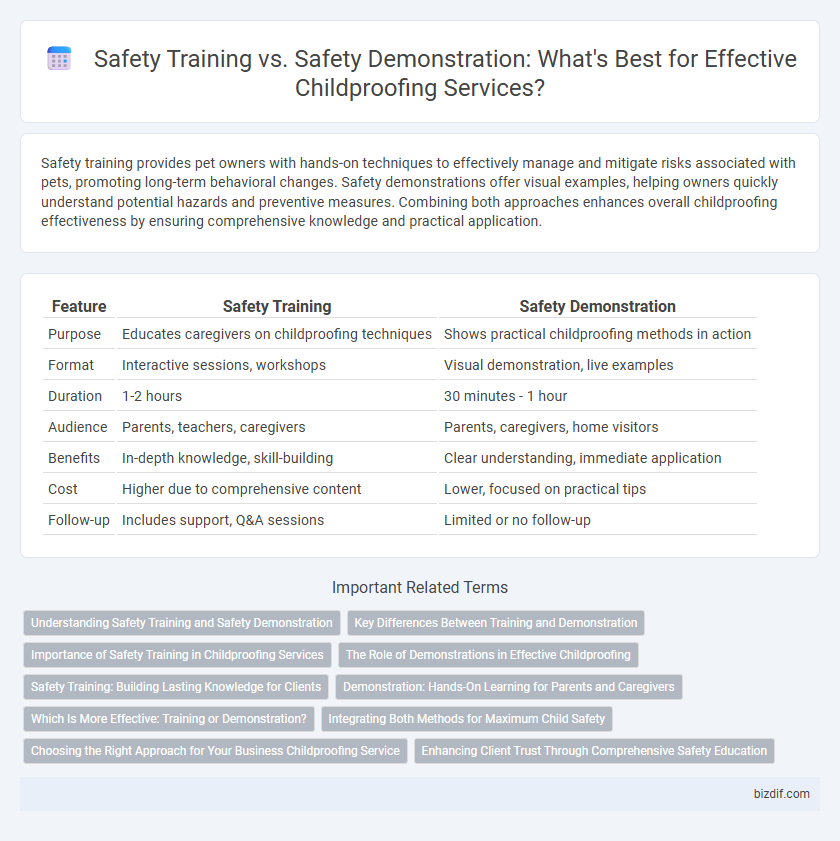Safety training provides pet owners with hands-on techniques to effectively manage and mitigate risks associated with pets, promoting long-term behavioral changes. Safety demonstrations offer visual examples, helping owners quickly understand potential hazards and preventive measures. Combining both approaches enhances overall childproofing effectiveness by ensuring comprehensive knowledge and practical application.
Table of Comparison
| Feature | Safety Training | Safety Demonstration |
|---|---|---|
| Purpose | Educates caregivers on childproofing techniques | Shows practical childproofing methods in action |
| Format | Interactive sessions, workshops | Visual demonstration, live examples |
| Duration | 1-2 hours | 30 minutes - 1 hour |
| Audience | Parents, teachers, caregivers | Parents, caregivers, home visitors |
| Benefits | In-depth knowledge, skill-building | Clear understanding, immediate application |
| Cost | Higher due to comprehensive content | Lower, focused on practical tips |
| Follow-up | Includes support, Q&A sessions | Limited or no follow-up |
Understanding Safety Training and Safety Demonstration
Safety training provides comprehensive education on childproofing techniques, equipping caregivers with essential skills to prevent accidents effectively. Safety demonstrations visually showcase proper use of childproofing products, enhancing understanding through practical examples. Combining both approaches ensures thorough knowledge and confidence in maintaining a safe environment for children.
Key Differences Between Training and Demonstration
Safety training involves thorough education and skill development to equip caregivers with the knowledge and techniques needed for childproofing, emphasizing hands-on practice and comprehensive understanding. Safety demonstration provides a visual walkthrough of childproofing methods, highlighting specific actions and tools without requiring active participation from observers. The key difference lies in training fostering active learning and retention, whereas demonstration primarily serves as an observational guide to reinforce safety principles.
Importance of Safety Training in Childproofing Services
Safety training in childproofing services equips caregivers and parents with essential knowledge and practical skills to identify potential hazards and implement effective safety measures, significantly reducing the risk of childhood injuries. Comprehensive training covers emergency response techniques, proper use of safety devices, and ongoing safety awareness, creating a proactive environment tailored to each child's needs. Prioritizing safety training ensures long-term protection and confidence in maintaining a secure home environment for children.
The Role of Demonstrations in Effective Childproofing
Safety demonstrations play a crucial role in effective childproofing by providing hands-on, visual examples that help caregivers understand the practical application of safety measures. Unlike theoretical safety training, demonstrations engage participants by showing how to correctly install safety devices and identify potential hazards in real-time environments. This approach enhances retention and empowers parents to create a safer home for their children through experiential learning.
Safety Training: Building Lasting Knowledge for Clients
Safety training in childproofing services focuses on building lasting knowledge by teaching clients comprehensive techniques and preventive measures to maintain a secure environment. Unlike a safety demonstration that shows specific actions briefly, training engages clients through interactive learning, ensuring they understand the rationale behind safety practices. This approach empowers caregivers to respond effectively to potential hazards, creating long-term protective habits.
Demonstration: Hands-On Learning for Parents and Caregivers
Safety demonstration in childproofing provides hands-on learning opportunities for parents and caregivers, allowing them to actively engage with safety equipment and techniques. This immersive approach enhances understanding and retention of critical safety measures, ensuring practical skills are developed for real-life application. Interactive demonstrations foster confidence and preparedness, reducing risks and promoting a safer home environment for children.
Which Is More Effective: Training or Demonstration?
Safety training in childproofing offers comprehensive knowledge through interactive lessons, enabling caregivers to understand and apply safety measures effectively. Safety demonstrations provide visual, real-time examples of hazard prevention, making abstract concepts easier to grasp and remember. Combining both methods enhances retention and practical application, but training often proves more effective for long-term behavior change by engaging multiple learning styles and encouraging active participation.
Integrating Both Methods for Maximum Child Safety
Combining safety training and safety demonstrations creates a comprehensive childproofing approach that enhances understanding and practical application of safety measures. Safety training provides essential knowledge about potential hazards, while safety demonstrations offer hands-on experiences that reinforce these concepts in real-life scenarios. Integrating both methods maximizes child safety by ensuring caregivers and children are well-informed and prepared to prevent accidents effectively.
Choosing the Right Approach for Your Business Childproofing Service
Safety training involves structured education sessions that equip employees with comprehensive knowledge and skills to prevent child-related hazards, while safety demonstrations provide practical, hands-on examples that illustrate specific childproofing techniques. For a business childproofing service, selecting the right approach depends on the goals: training builds long-term competence and compliance, whereas demonstrations enhance immediate understanding and application. Combining both methods can optimize employee preparedness, ensuring effective implementation of child safety protocols in client environments.
Enhancing Client Trust Through Comprehensive Safety Education
Safety training offers in-depth instruction with hands-on practice to ensure clients thoroughly understand childproofing techniques, while safety demonstrations provide visual examples to illustrate proper safety measures. Combining both approaches enhances client trust by delivering comprehensive education that empowers caregivers to create secure environments. Effective communication of safety protocols reduces risks and fosters confidence in childproofing services.
Safety Training vs Safety Demonstration Infographic

 bizdif.com
bizdif.com